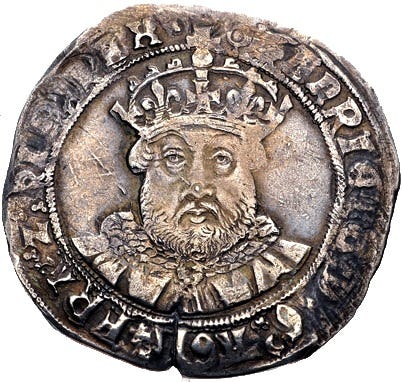Old Copper Nose
How Henry VIII debased the currency & earned this nickname
Henry VIII is one of England’s most infamous historical monarchs and is universally famous for the following:
Having 6 wives
Beheading 2 of them
breaking away from the catholic church and having Parliament name him as supreme head of the church of England
The dissolution (ransacking) of the monasteries
He is slightly less famous for what is now known as ‘The Great Debasement’.
When Henry VIII mounted the throne in 1509 there were 3 coins that made up the currency in circulation:
Silver penny (cheapest coin)
Silver Groat (worth 4 pennies)
Gold Angel (worth 120 pennies)
The silver coins retained their purchasing power from 1509 to 1526 while the Gold Angel retained its value past Henry himself. In 1526 Henry found himself in need of cash and did what governments and dictators around the world always end up doing, he started screwing around with the money (notably the silver).
To raise the money he introduced new coins. The gold crown, the half-crown and a new silver coin with reduced metal content.
Silver Penny
Half Crown
Gold Crown
These coins remained like this until 1542 when Henry started reducing the amount of silver in the silver pennies and the silver groats.
When Henry reformed the monetary system in 1526 he introduced new gold coins, the crown and half-crown. Silver coins minted between 1526 and 1544 featured reduced metal content. The gold angel’s metal content remained the same up through the end of Henry’s reign in 1547.
In May 1542 stuff got really spicy. Henry issued a secret indenture to start reducing the amount of silver in pennies and groats. To keep the weight the same and to hide the debasement Henry created copper coins and gave them the thinnest covering of silver possible. These coins were minted for 2 years before they were released into general circulation.
The fun thing about these silver coated copper coins was that the Henry’s nose was the bit that stuck out the most on the coins. As the coins rubbed against each other in people’s pockets the silver on the nose was the first to rub off, leaving Henry with a reddish nose and earning him the nickname ‘Old Copper Nose’.
Henry continued to cut back on the gold and silver in his coins in order to cover his over expenditure until his death. King Edward continued the debasement further.
This debasement which was used to finance Henry’s extravagant lifestyle and the wars with Scotland and France led to a breakdown of trust in the monarchy. It wasn’t until 1560 that Queen Elizabeth restored the currency to its previously high standards. The Queen withdrew all debased coins from circulation and reminted them to the previously high standard.
How Did The Debasement Affect The Country?
In a word, inflation. Once Henry’s scam had become public knowledge people started hoarding the older coins as they were known to still have value. Merchants started offering lower amounts of product for the debased coins which led to increased prices for everyone that had accepted the new currency. Abroad bankers refused to accept the English coins, insisting instead to be paid in gold. This led to gold shortages as people hoarded the more valuable coins instead of using them for transactions.
It was a mess.
Before Henry screwed everything up the English coinage had been a trusted currency for centuries. It wasn’t until 1560 that Elizabeth was able to reset the standard and bring normality back to the country’s finances.
The moral of the story… Don’t mess with the money!
Until next time
The Wealth Gap





